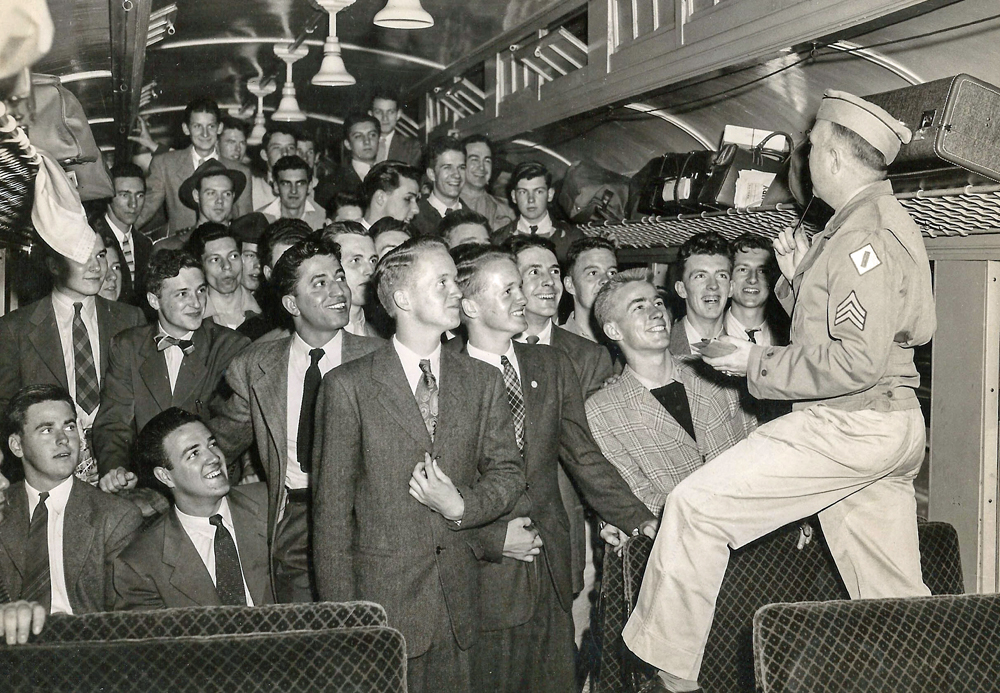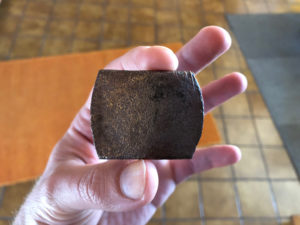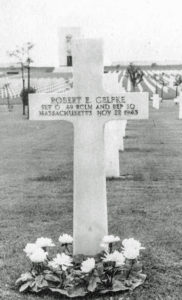True Tales: Pt. 2 – Day of Sorrow
By George T. Comeau
Army Air cadets are all smiles as they head off to training from North Station in May 1943 before joining the war effort. Shown in the foreground are twin brothers Robert and Roy Gelpke of Canton. (Courtesy of David Gelpke)
Below is the second in a two-part story about the Gelpke twins of Canton. Click here to return to part one, “Giving Thanks.”
Bob and Roy Gelpke, twins that had never spent a day apart, left Canton together in May 1943. They can be seen smiling on a troop transport train as it leaves North Station in Boston. Their eyes beaming and standing at the head of the train as a sergeant works to create order out of chaos. There must be 30 young men — all smiling at the prospects of joining the war effort in Europe.
Bob stands to the left, looks on softly, and Roy to the right — wide grin and engaging eyes. Each young man dressed in a suit jacket. Bob in a tweed with a paisley tie and his twin brother with tightly knotted plaid tie against a grey suit. The photographer has sized up the subjects and puts the Canton boys at the center of his photo. It is perhaps the last photo of these two brothers together before they would be separated for the first time in their young lives.
Both brothers were stationed and trained stateside. Bob wound up at numerous locations. His first stop was Jefferson Barracks, the oldest operating U.S. military installation west of the Mississippi River. During World War II, Jefferson Barracks was a major reception center for U.S. troops being drafted into the military. It also served as an important basic training site for the Army, then later was the first Army Air Corps training site. It was here that Bob began his flight training. Later he would be assigned to bases in Chickasha, Oklahoma; Coffeyville, Kansas; Perry and Tallahassee, Florida; and finally receiving his appointment as a flight officer at Aloe Field in Victoria, Texas in April 1945. It was at Perry, Florida that Bob came to meet Harold Kotora. They trained together learning to fly P-40 fighter planes. They would travel together and their lives would cross several times over the next seven months. Kotora would be the last man to see Bob alive, and among the first to see him dead.
The war was winding down, and fast — much to the relief of the Gelpke family back home in Canton. By early 1945, Germany’s military situation was on the verge of total collapse. Poland had fallen to the advancing Soviet forces. German forces had recently lost to the Allies in the Ardennes Offensive, with British and Canadian forces crossing the Rhine into the German industrial heartland of the Ruhr. American forces in the south had captured Lorraine and were advancing towards Mainz, Mannheim, and the Rhine. In Italy, German forces were withdrawing north. And, the surest sign of the end in sight: the Allies met at Yalta in February to discuss the conclusion of the war in Europe.
On April 1, 1945, Bob Gelpke left Tallahassee and joined the 8th Air Force near Cambridge, England. It was here at RAF Fowlmere that Bob and the rest of the boys nicknamed Kotora “Stan.” The 500th Squadron was a tightknit group and all agreed that Bob’s flying ability was top notch. Fowlmere Airfield, formerly RAF Fowlmere, near the edge of the village, was the location for the RAF Station and transferred to the United States Army Air Force (USAAF) for use by their 339th Fighter Group during World War II. The group flew its first combat mission on April 30, 1944, and its last on April 21, 1945. It was here, for a brief moment at the end of the war, that Bob flew dozens of combat missions.
By the end of April, Adolph Hitler had committed suicide and the war ended within weeks. As peace ensued, there was plenty of work for the military as attention turned to establishing and managing civilian governmental affairs. Bob and Stan were transferred to Hanau, Germany, and were roommates for a short time. Eventually Bob was transferred to an abandoned Luftwaffe base 100 miles south of Hanau and quite near Stuttgart. Bob found himself flying mail deliveries from Göppingen, a small town in southern Germany, part of the Stuttgart Region of Baden-Württemberg. The new assignment made Bob a member of the 49th Reclamation and Repair Squadron.
On November 22, 1945, as the Gelpke family in Canton celebrated Thanksgiving, Bob and Stan sat down to an early morning breakfast and cracked jokes. Bob was 20 years old. A birthday celebration would be planned for three days hence. But first there was work at hand.
Bob climbed into the small cockpit of the UC-78 that was assigned to him that day. The plane had been built in 1943 and had a little over 400 logged flight hours. Bob had flown this type of aircraft for 12 flight hours. Yet, at this point the young man had logged over 337 hours flying — certainly he was well trained and seasoned.
The UC-78 was a twin engine cargo utility plane. First flown in 1939, it was a simple Cessna design of wooden wings and tail, with a welded steel-tube fuselage. The plane was covered in fabric, which made the aircraft relatively light for its size and made it fairly durable. It was powered by two Jacobs R-775 engines, producing 245 horsepower each. During its lifetime, this plane earned several infamous names, the first being the “Bamboo Bomber,” which was a reference to the primary wood construction. The name “Useless 78” was coined because of its low payload when fully fueled. This was the last plane that Bob would fly.

Robert Gelpke’s uniform belt buckle recently recovered from the crash site (Courtesy of Phillip Götz)
In part this is what the accident report read: “Pilot took off from Hanau, Germany at 0926 on 22 Nov. ‘45 on route to Goppingen, Germany. According to reports from German civilians in the area of the crash he was flying very low. Civilians cutting wood nearby heard the crash and immediately went to the plane. The pilot was dead when they arrived. The engine sounded smooth and there was no sound of a surge of power which indicates that the pilot did not see the hill. From the reports available it can be assumed that the pilot attempted to fly under the weather. Pilot had sufficient gas to go to destination and return. The crash occurred at approximately 0950.”
Nine days after Thanksgiving and six days after what would have been Robert Edgar Gelpke’s 21st birthday, Charles and Julia Gelpke wept for the loss at the notification from the War Department. The war had been over, and yet the deepest of losses crossed the threshold on Pleasant Street — November 30 became a day of sorrow.
Philipp Götz is a 33-year-old teacher in Beerfelden, Germany. He teaches German language and literature as well as politics and social studies. In his free time, history has become his passion. And lately, the crash of Gelpke’s plane has taken focus.
When I asked him why he was so intrigued to discover the crash site of Gelpke’s plane, he wrote, “I became aware of a crash of a British bomber in a forest near to the house I live. I began researching this case, talked to many contemporary witnesses, and learned that there was a big number of plane crashes in my home region. Around one and a half years ago, a friend of my father told me that an American plane crashed shortly after the war near his home town Schlossau. This was Robert Gelpke’s plane. From this day on, I started my research.”
The research work that Götz has undertaken has now crossed the Atlantic to Canton. Götz sent along the crash report, several photos and modern-day reconstruction of the crash site. The site is about 14 miles from Götz’s home and he has visited it frequently, collecting small parts of the plane — instruments, portions of the flight deck, and even parts of the engine. A steering control, the yoke of the actual plane, is now recovered.
Götz has tracked down and interviewed three people who vividly recall the crash that day.
One man, Bernhard Damm, is around 85 years old. Damm tells Götz, “On the next morning I walked to the crash site and saw a horrible scene of total destruction. When I looked around I saw plane parts everywhere. The airplane was totally destroyed.” Damm looked into the cockpit and saw the bloodied pilot seat. Even today Damm remembers the exact location of the crash in the forest. He told Götz that he can’t get the pictures out of his head and is still so sorry about what happened to the pilot.

The grave of Robert E. Gelpke at the American Cemetery in Saint Avold, France (Courtesy of Leslie Larusso)
Asking Götz how he feels now that together we have pieced the life and the last moments of that life, he responds, “It’s really a great feeling now to know so much more about Robert Gelpke, his family background, and his last flight on that day. For me it is so important that this young man, who gave his life for our freedom, is not to be forgotten. It’s my main goal that the people in my region here in Germany learn more about the background of the crash so that this won’t be only a mostly forgotten, anonymous crash site anymore. Robert Gelpke deserves [to be] remembered here in honor. When I tell my students about this terrible time of war, I often use the case of Robert Gelpke as an example so that they understand how lucky they are to live in peace here today in Germany.”
Within hours of the crash, Lieutenant Kotona, “Stan,” was dispatched to investigate. Knowing that it was his best friend lent an urgency to the mission. The woodcutters had rushed to the plane and found Gelpke “beyond help.” An ambulance had been dispatched from a town 20 miles away. A second ambulance was dispatched from the 130th General Hospital in Heidelberg. Kotona wrote in a letter to Charles and Julia, “I know that all these facts are just as I’ve told you, because I was detailed to investigate the crash. I first flew to Heidelberg to identify Bob and then travelled to the scene.” The loss was devastating to a dear friend.
Along with the letter to the family, Kotona sent along silk scarves. “These silk scarves are the ones Bob was having made by a German woman in a small town near Hanau,” Kotona explained. “She just completed them … I feel that you should be very proud of his accomplishment as an Army fighter pilot and that his accident is one of the many unfortunate ones it brought about by the war. I am proud to have flown with him and had him as my friend. I hope this letter will help you to understand everything more clearly and I extend my deepest sympathy to you all.”
Gelpke was buried in a small cemetery near Hanau. Soon the family decided to have him exhumed and moved to a military cemetery.
After Charles Gelpke died in 1952, Julia traveled to her son’s grave at the Lorraine American Cemetery in St. Avold, France. The family has returned in recent years to pay tribute to the hero from Canton. Götz is working to suitably memorialize the crash site and plans to share some of the artifacts from the plane with the people of Canton.
Special and sincere thanks is extended to David Gelpke, Christina Dunnell, Leslie Larusso and Phillip Götz.
Short URL: https://www.thecantoncitizen.com/?p=46333










